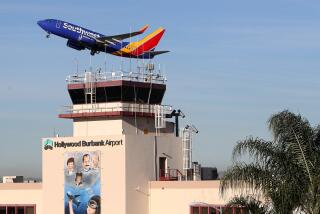Delays in Plane Flights Cost All of Us Big Bucks
- Share via
When was the last time your flight got off the ground right on schedule? It’s been so long since I had a truly on-time departure that I’m beginning to believe it can’t be done any more.
I’ve lost count of the number of times the pilot has apologized to me and a few hundred other passengers for delays caused by mechanical malfunctions, weather, late arrival of a connecting flight or because the bags hadn’t been stowed.
I remember one explaining that he couldn’t take off because the flight engineer hadn’t appeared.
But nowadays the most common excuse for not leaving on time is that air traffic control can’t handle the volume of flights. It’s not only the most common, it’s also the most exasperating and the most expensive.
Delays Nationwide
Air traffic control delays nationwide during the summer months, according to the Air Transport Assn., kept planes on the ground about 2,500 hours a day longer than they should have been.
That’s the equivalent of 10 hours of down time for 250 aircraft. Put another way, it’s the equivalent of grounding one major air carrier every single day through the busy season.
In other, less hectic periods the rate drops, but hardly to an acceptable level. Over the course of the entire year the industry still manages to rack up about 2,000 hours a day in ATC delay.
It’s a little more than a gigantic pain in the neck, a monster inconvenience, especially if you happen to be a business traveler.
Work out the value of your time by the hour, multiply it by the number of hours you spend waiting at the gate or on the runway “sixth in line for takeoff,” and you see that it adds up to a tidy sum.
It’s Costing $2 Billion
The ATA estimates that delays will cost the airlines, and their passengers, about $2 billion this year. And the airline trade organization does not see any immediate relief in sight.
What’s the answer? How do we correct this intolerable situation?
One step in the right direction would be to hire more air traffic controllers. The Federal Aviation Administration has been authorized by Congress to hire an additional 500 in the near future. But that may not even be enough, according to some observers, who consider that 1,000 or more might be more appropriate.
But if you hired an extra 1,000 or 5,000 controllers, that wouldn’t be the answer. They’d have to be given something to work with--new computerized control and communications systems. Too many of our control towers are not just understaffed, they’re inadequately equipped.
Solution Isn’t Cheap
You can revise FAA rules to provide for more departures and landings, closer together, without seriously compromising flight safety. Most experts agree on that.
But you won’t solve the problem, either. Only a combination of upgraded equipment, bigger staff and perhaps rule changes, as well, will.
The solution won’t come cheap.
Which brings me to a subject that I’ve talked about in this column before, the aviation trust fund, which you and I have financed and continue to finance, through a tax on every domestic ticket we buy.
That fund, established by the federal government several years ago, is meant to be used to improve the airport/air control system.
It shows a surplus of $4.3 billion, which simply isn’t being used for the intended purpose. It isn’t being used for anything, in fact, unless it’s to make general fund figures look better. The General Accounting Office refuses to recognize it as anything but a contribution to the federal coffers.
Soaring Toward $10 Billion
The ATA believes that the fund, at its present rate of expansion, will have reached a bloated $10 billion before the end of the decade if we don’t start to use it. What better time to use it than now, when our air traffic control system so desperately needs it?
New automation must be developed, and the hiring and training of staff must be given a high priority. It’s galling to consider that these things could be done with money that I’ve already paid but that some bureaucrat is keeping locked up in the government vaults.
The ATA makes one suggestion that won’t meet with universal approval. The association is proposing that a new federal corporation be established to develop and improve our airports, using trust fund money, of course.
The argument in favor is that such a body would be able to react more quickly and decisively to aviation’s needs and pressures than can the red-tape shackled, often highly politicized FAA. And the FAA, after all, would continue to regulate air safety and security--everything but air traffic control.
Don’t Need Another Bureau
The argument against is that if there’s one thing we do not need it’s another arm of the federal bureaucracy. Especially one on which the airlines, who have a vested interest, would presumably be in a position to exert a lot of pressure.
Some have suggested, in fact, that the ATA is making a bid to take over air traffic control matters itself, a most unhealthy state of affairs. Be that as it may, the ATA-backed bill to establish a National Aviation Authority will probably be introduced in Congress early in 1987.
It is certain to encourage heated debate and renewed cries for release of the aviation trust fund money now hoarded so jealously by the GAO.
More to Read
Inside the business of entertainment
The Wide Shot brings you news, analysis and insights on everything from streaming wars to production — and what it all means for the future.
You may occasionally receive promotional content from the Los Angeles Times.









